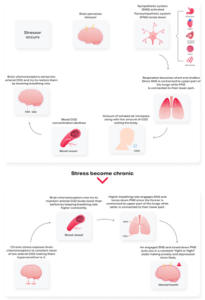For thousands of years, humans have intuitively understood the power of breath. Across cultures – from ancient Greece to India and China, breathing was revered as a healing force and an essential life mechanism. Breath was more than survival; it was transformation.
Yet, in the modern age, we’ve largely lost touch with this practice. Western medicine’s focus on pharmaceutical intervention led to the marginalization of many natural healing tools – breathwork included. But in recent years, both science and society have reawakened to the profound influence of breathing, especially when it comes to stress and mental well-being.
The Bi-Directional Relationship Between Breath and Stress
Breathing doesn’t just reflect our state of mind – it influences it. The connection between breath and psychological stress is deeply rooted in our biology, involving the lungs, brain, and nervous system.
Let’s walk through the mechanism that links stress to dysfunctional breathing.
Step-by-Step: How Stress Affects Breathing
Step 1: Sensory Trigger
A stressor is perceived through the senses, prompting a signal to the brain.
Step 2: Nervous System Activation
The Autonomic Nervous System (ANS) kicks in. It’s two branches – Sympathetic (fight or flight) and Parasympathetic (rest and digest) – determine how your body responds. Stress rapidly activates the Sympathetic system, diminishing the calming effects of the Parasympathetic.
Step 3: The Brain-Lung Axis
Your brain communicates with your lung via the vagus nerve. The upper lungs are linked to the Sympathetic system, the lower lungs to the Parasympathetic. When you’re stressed, breathing becomes shallow and rapid (chest breathing), keeping you locked in flight-or-flight mode. In contracts, deep belly breathing activates the calming Parasympathetic System.
Step 4: CO₂ Levels Drop
Faster breathing reduces carbon dioxide (CO₂) in the bloodstream. This disrupts two vital functions:
- Oxygen Delivery: CO₂ help oxygen release from hemoglobin into your cells.
- Blood Flow: CO₂ helps dilate blood vessels. Lower levels lead to constricted arteries and less oxygenated blood reaching your brain.
Step 5: Brain Tries to Compensate
The brain detects low CO₂ and adjusts the breathing rate. However, if stress persists, this feedback loop becomes maladaptive.
Step 6: Chronic Hyperventilation
With time, your body adapts to faster breating and lower CO₂ – a condition know as Chronic Hyperventilation Syndrome (CHS). This impairs brain oxygenation, reduces cognitive clarity, and can contribute to anxiety or mood disorders.
Step 7: The Cycle Continues
Shallow, rapid breathing keeps the Sympathetic system engaged, which leads to more stress creating a self-reinforcing loop.
Here is a visual representation of these steps:

Breathwork: A Path Out of Chronic Stress
The good news? Breathing is the only core physiological process we can consciously control. That gives us a powerful tool to break the stress cycle.
Deliberate breath control, or breathwork, can re-engage the Parasympathetic nervous system, restore healthy CO₂ levels, improve oxygen delivery, and reduce psychological stress.
Different breathwork techniques target different parts of the breathing apparatus. Some of the most popular include:
- Box Breathing: even counts of inhale, hold, exhale, hold (e.g., 4-4-4-4)
- Diaphragmatic Breathing: Deep belly breathing to activate lower lungs
- Alternate Nostril Breathing: A yogic practice that balances nervous system
- Resonate Breathing: Slow breathing (~6 breathes/min) to increase HRV (Heart Rate Variability)
Summit Peaks & Breathwork
At Summit Peaks Altitude Training, we incorporate breath analysis and training into our holistic approach to health and performance. Using tools like the PNOĒ metabolic analyzer, we assess your breathing patterns, CO₂ levels and lung efficiency – then help you optimize them for your goals.
Whether you’re aiming to manage stress, enhance mental clarity, or recover faster, our altitude environment and breathing protocols are tailored to help you regulate your nervous system from the inside out.
Breath as the Gateway to Mental Health
Breathing can be your body’s greatest ally or biggest saboteur when it comes to mental well-being. Recognizing the role your breath plays in the stress cycle is the first step to reclaiming control. With intention, awareness, and practice, breathwork can become a daily ritual that empowers your nervous system and uplifts your mind.
If you are curious as to how Summit Peaks Altitude Training can help you decrease your stress, improve your mental health and take your fitness to the next level reach out
